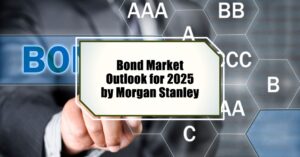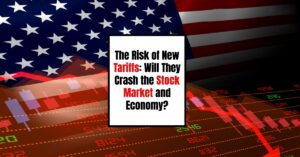What's the vibe in the bond market for 2025? According to Morgan Stanley, it's all about being selective and flexible. With uncertainty swirling around U.S. fiscal policy and the economy, investors should carefully consider specific sectors like corporate credit, securitized credit, and emerging-market debt to potentially find value and diversify their portfolios. Instead of blindly following benchmarks, it's time to roll up our sleeves and find the hidden gems.
Bond Market Today and Outlook for 2025
Let's be honest, the market feels a bit like a rollercoaster right now. We're all trying to figure out what's next, especially with potential shifts in U.S. fiscal policy creating waves. Heightened volatility seems to be the name of the game, and it’s likely to stick around for a while. This isn’t necessarily a bad thing, though! Volatility can create opportunities for savvy investors who know where to look.
Think of it like this: imagine you're at a crowded flea market. There are tons of things, some valuable, some not so much. If you just grabbed the first thing you saw, you might not get the best deal. But if you took your time, looked closely, and knew what you were looking for, you could find a real treasure. That's the approach we need to take with the bond market in 2025.
Morgan Stanley suggests a few key principles to guide our strategy:
- Select Actively: Don't just blindly follow the herd. Actively manage your portfolio, looking for securities that are mispriced. Exploit those market inefficiencies to outperform passive benchmarks.
- Focus on Credit Quality and Risk-Adjusted Returns: Dig deep into the specifics of each bond. Don't be swayed by tight spreads on investment-grade or expensive high-yield bonds.
- Optimize the Mix: Diversification is still key. A mix of U.S. Treasuries, corporate bonds, securitized credit, and emerging-market debt can help you ride out the bumps.
- Assess Macro Conditions: Keep a close eye on those big-picture factors, like potential shifts in fiscal policy, monetary policy, and their ripple effects on credit markets.
Finding Opportunities in a Selective Market
So, where should we be focusing our attention? Here are some areas Morgan Stanley highlights:
Corporate Credit: Strength in Selectivity
Despite all the uncertainty, it's good to remember that corporate balance sheets are generally in pretty good shape as we enter 2025.
- Investment-grade company fundamentals are still looking strong, offering some stability.
- However, be aware of how tariffs might affect global supply chains, especially in sectors like autos and retail.
- Instead of broad exposure through passive indices, focus on high-quality issuers with strong balance sheets.
- High-quality bonds may be more attractive than bank loans, especially given slow economic growth and a potentially dovish Federal Reserve.
I think the key takeaway here is to do your homework. Don't just assume that all corporate bonds are created equal. Look for those companies that are well-managed, have strong financials, and are likely to weather any potential storms.
Securitized Credit: A Solid Performer
Securitized credit (think asset-backed securities, commercial mortgage-backed securities, and mortgage-backed securities) performed well in 2024 and the beginning of 2025.
- Agency mortgage-backed securities (MBS) have even outperformed investment-grade and high-yield sectors.
- MBS and asset-backed securities often offer higher-yield spreads than traditional investment-grade corporate bonds.
- Strong consumer credit fundamentals and the resilience of U.S. households support structured credit markets.
- You can also move up the capital structure by investing in higher-rated tranches (AAA or AA), capturing attractive risk-adjusted returns.
My take on this is that securitized credit offers a good balance of risk and reward. It's not as flashy as some other investments, but it can provide a steady stream of income and help to diversify your portfolio.
Emerging-Market Debt: Targeting Stability
Emerging markets can be a bit of a wild card, but there are opportunities to be found if you're careful.
- Look for countries with strong fundamentals and central banks willing to cut rates.
- Target countries with stable growth, improving fiscal positions, and proactive monetary policies.
- Continued U.S. dollar weakness could be a positive for emerging-market currencies.
- Focus on emerging-market countries that are more shielded from U.S. policies.
Personally, I believe that emerging markets require a deeper level of due diligence. It's not enough to just look at the headline numbers. You need to understand the political and economic context of each country to make informed decisions.
Riding the Yield Curve: Curve Steepeners
The yield curve is expected to steepen, which means that long-term bond yields could rise relative to short-term yields.
- The U.S. Treasury yield curve steepened after the tariff announcement.
- Consider curve steepeners (overweighting shorter-term bonds matched with an underweight to longer-term bonds).
- Duration management is also crucial, especially with the Federal Reserve expected to cut rates gradually.
From my perspective, paying attention to the yield curve is critical for fixed-income investing. It offers key insight into how the market perceives the economic outlook and, thus, provides valuable hints for positioning your portfolio.
The Big Picture: Navigating Volatility for Potential Gains
Even with all the uncertainty, fixed income can still play a vital role in portfolios, providing a strong negative correlation to risky assets. Institutional investors should focus on those key areas: being active, prioritising credit quality, optimizing mix, and assessing macro conditions. U.S. fixed-income allocations may provide the potential for income, total returns, and diversification.
Starting yields are also at their highest levels since the financial crisis. Historically, high starting yields have been a reliable indicator of future returns, suggesting that bonds with higher yields at the time of purchase may offer greater total returns over time.
Ultimately, the 2025 bond market is all about being selective and flexible. By focusing on specific sectors, carefully evaluating credit quality, and paying attention to the overall macroeconomic environment, we can navigate the volatility and potentially find some attractive opportunities.
Disclaimer: I'm just sharing my thoughts and insights based on the Morgan Stanley report. This isn't financial advice, and you should always do your own research before making any investment decisions.
Work With Norada – Build Wealth
With economists warning of stagflation and weak Q1 GDP due to tariffs, now is the time to invest in stable, income-generating real estate for financial security.
Norada’s turnkey rental properties provide consistent cash flow and long-term wealth, no matter the economic climate.
Speak with our expert investment counselors (No Obligation):
(800) 611-3060
Read More:
- The Risk of New Tariffs: Will They Crash the Stock Market and Economy?
- Stagflation Alert: Economist Survey Predicts Weak Q1 GDP Due to Tariffs
- Goldman Sachs Significantly Raises Recession Probability by 35%
- 2008 Crash Forecaster Warns of DOGE Triggering Economic Downturn
- Stock Market Predictions 2025: Will the Bull Run Continue?
- Stock Market Crash: Nasdaq 100 Tanks 3.5% Amid AI Concerns
- Stock Market Crash Prediction With Huge Discounts on Bitcoin, Gold, Houses
- S&P 500 Forecast for the Next Year: What to Expect in 2025?
- Stock Market Predictions for the Next 5 Years
- Echoes of 1987: Is Today’s Stock Market Crash Leading to a Recession?
- Is the Bull Market Over? What History Says About the Stock Market Crash
- Wall Street Bear Predicts a Historic Stock Market Crash Like 1929
- Economist Predicts Stock Market Crash Worse Than 2008 Crisis
- Next Stock Market Crash Prediction: Is a Crash Coming Soon?
- Stock Market Crash: 30% Correction Predicted by Top Forecaster




